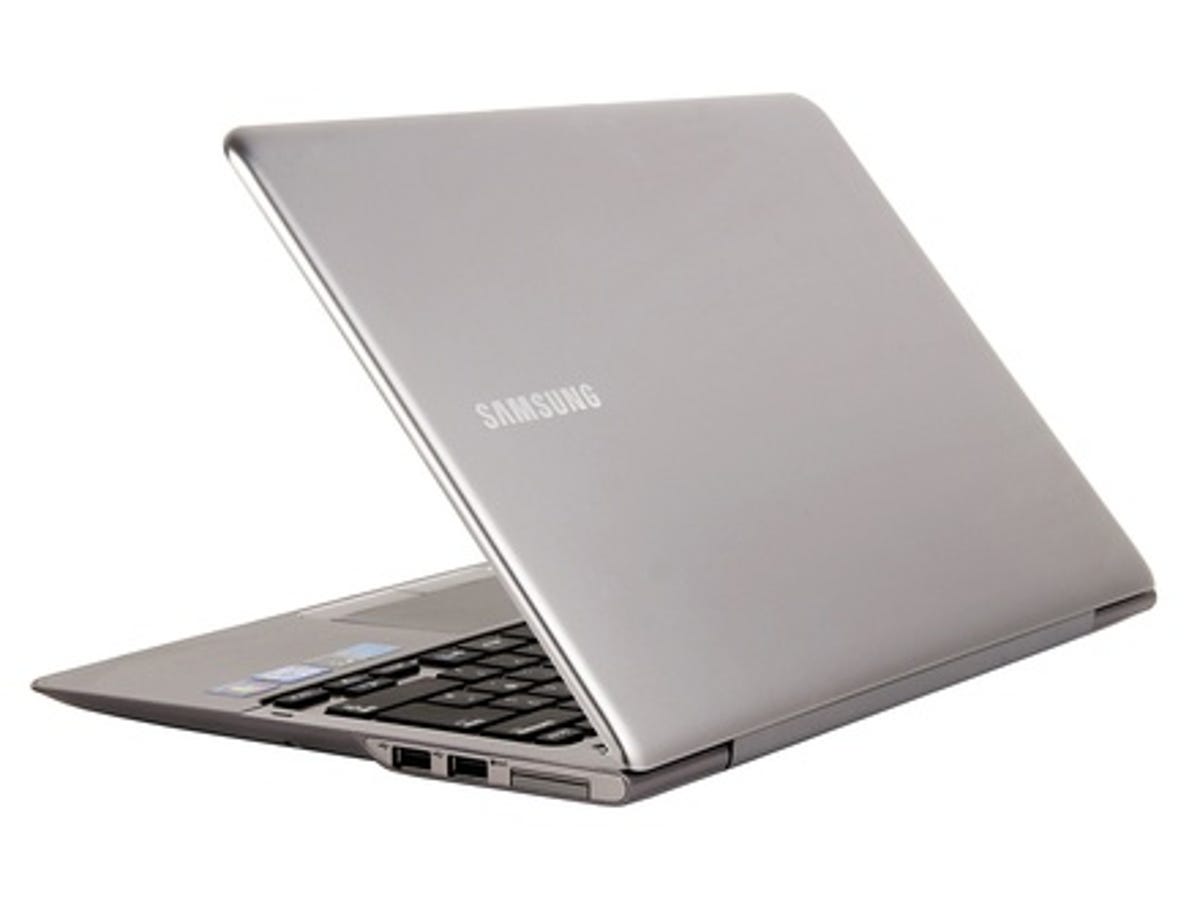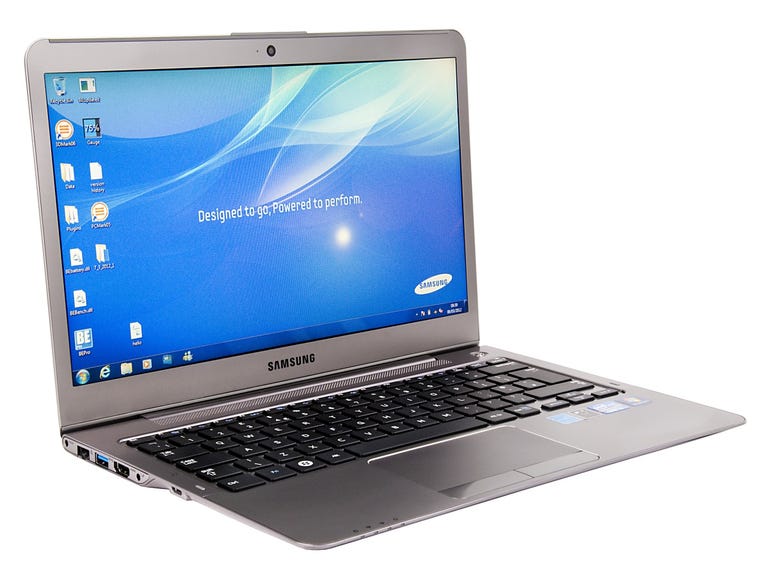 Why You Can Trust CNET
Why You Can Trust CNET Samsung Series 5 ultrabook review: Samsung Series 5 ultrabook
The Samsung Series 5 ultrabook offers a clean design, but sadly its performance and screen resolution don't justify the high price.
The term ultrabook has been well and truly established in the past year, with a raft of slim and sexy models launched. The 2012 additions are starting to trickle out now, with Samsung being the first to put a new machine in my hands, having showed it off at CES in Vegas earlier this year.
The Good
The Bad
The Bottom Line
The Series 5 offers a clean, sensible design and packs an Intel Core i5 processor, 4GB of RAM and a 500GB hard disk drive, instead of the solid state drives you'd expect to see in an ultrabook.
It's on sale now and will set you back £800 for the 13.3-inch version I tested, or £900 for the 14-inch model, which also packs in a DVD drive.
Design
So you want a flashy new laptop with colourful patterns and fancy, modern design, do you? Well, you're out of luck here as the Series 5 is a subdued beast. Instead of garish styling, it offers a rather more mature design. A silver-grey colour is to be found covering every part of the chassis, with nothing in the way of accents, edging or patterns.

The only thing that punctuates the vast expanse of grey colouring on the lid is the subtle Samsung branding. Despite this, it somehow manages to avoid being boring. I personally think it's very smart -- it's a look that's more suited to attending business conferences than working on your poetic novel in Starbucks though.
The Series 5 is similar in design to the businesslike Toshiba Satellite Z830. If you're looking for an ultrabook with more design flair, then check out the attractive spun metal finish on the Asus Zenbook UX21.
Size wise, the Series 5 is par for the course. It's 315mm wide and 220mm deep, which are great dimensions for sliding into a briefcase or one of those stylish messenger bags. At just under 18mm thick, it's not the slimmest ultrabook on the market, but it's far from fat.
It weighs in at 1.43kg, which is standard for most ultrabooks. The Zenbook UX31 clocks in at around 1.3kg, undercutting the Series 5 slightly. Whether you'd ever notice that difference when you're carrying it around is debatable.
Around the sides you'll find one USB 3.0 and two USB 2.0 ports, an Ethernet slot that has a cunning fold-out design to reduce overall size, a combined headphone and microphone jack and a VGA input that works with a supplied adaptor.
Unusually for ultrabooks, you'll also be able to get a DVD drive. It's only on the 14-inch model, which has a little more body space to play with, so if you want to stick with discs for the next few years, make some room in your bag for the bigger version.
Keyboard and trackpad
The keyboard uses square keys with slightly rounded corners of the isolated variety. They're spread evenly over the base of the machine, with decent spacing between each key, and the typing experience is comfortable as they're easy to press.
I was able to type for extended periods without feeling the aches and pains that tell of an awkward keyboard. With a 13-inch chassis, there's no room for a numeric keypad on the side, but you can always grab a USB one if you particularly need to play with numbers.
The trackpad uses separate buttons, rather than being a clickable pad. While this often results in less space available to slide your finger around, the Series 5 still manages to provide a lot of pad real estate. There's a very slight ridge between the trackpad and the keyboard base, showing that Samsung has thought about how to use all the available space to fit in a big, comfortable trackpad.
Screen
The 13.3-inch screen offers a resolution of 1,366x768 pixels. I'm a little disappointed by this, as some of last year's models -- such as the Zenbook UX31 -- were offering 1,600x900 pixels and I'd hoped that this year's crop would at least be matching those specs, if not bettering them.
Annoyingly, you'll get the same resolution on the 14-inch model too -- I'd really have expected the larger size to up the resolution to at least 1,600x900 pixels, if not Full HD.
Mercifully, it's a pretty sharp display that's both bright and fairly vivid. I watched my favourite YouTube test clip and found that colours were warm and vibrant. The screen has been given a matte finish, which results in a slight reduction in overall brightness. It does, however, reduce reflections to practically nothing so it's great for use in bright sunlight or in changing lighting conditions.
Performance
Under the hood you'll find an Intel Core i5-2467M processor clocked at 1.60GHz, teamed with 4GB of RAM. Those are mid-range specs by last year's standards, so it looks as though there's not been much in the way of technical progression for 2012's ultrabooks.
When I unleashed the fury of the PCMark05 benchmark test, I was given a score of 5,821. The Asus Zenbook UX21 is also packing a Core i5 processor, but it managed to achieve over 9,000 on the same test, so the Series 5's effort is a let-down. Things seemed a little better on the Geekbench test though, as the Series 5 scored 5,650, which is more evenly balanced against the UX21's 5,828.
These scores certainly don't mean everything and probably shouldn't be the first things you look at when you're deciding between two machines, but considering the UX21 and the Series 5 are roughly the same price, it does seem like you're getting more power for your money from Asus' offering.
The Series 5 models we'll be seeing in the UK use the built-in graphics capabilities of the Intel chip, rather than a dedicated graphics card. I ran the 3DMark06 graphics benchmark test and was given a score of 2,282, which is about what I'd expect for this sort of machine. You're not going to be able to play recent games on it, but you might tackle some older titles if you knock the settings down to the bare minimum.
The Series 5 will be available with a dedicated AMD Radeon graphics card to help cut through the polygons, but for some reason, it's not being offered in Europe. Apparently Samsung doesn't see us Brits as being too keen on gaming. As such, I'd like to issue a challenge to Samsung's head of mobile computing to play me at Tony Hawk's Pro Skater 2.
In a rather peculiar move, Samsung has kitted the Series 5 out with a hard disk drive, rather than a solid state drive. While HDDs are more common in bigger laptops, the ultrabook ethos is all about size, speed and battery power -- three things that are easily compromised by an HDD.
For a start, they're physically bigger than SSDs, which explains the added bulk. They also offer slower read/write speeds than SSDs, which goes some way to accounting for the slightly lesser performance on the PCMark05 test. HDDs also have moving parts and it makes them more susceptible to knocks and bumps. That isn't ideal on a machine designed for life on the go.
Still, HDDs are cheaper so it does at least mean you get more space to store your photos and videos. The Series 5 offers a 500GB drive, whereas the 13-inch Zenbook UX31 has only 256GB.
Battery life
If you're going to be taking your machine on the road with you, you'll need a battery powerful enough to keep you working all day. I ran my battery benchmark test on the Series 5, which was able to keep going for 2 hours and 14 minutes.
That would be a good effort for a regular laptop, but for an ultrabook, I'm not exactly blown away. The UX31 managed to keep chugging along for 3 hours and 10 minutes, even with its more powerful processor. It's likely that the physical hard disk drive in the Series 5 is having a detrimental effect on battery performance.
It's a very demanding test that involves running the processor at a constant 100 per cent, so you'll find you can get much better battery life if you're more cautious with your usage. If you keep wireless connections turned off, screen brightness as low as you can cope with and don't run any unnecessary programs, you shouldn't worry too much about finding a plug socket away from home.
Conclusion
While the Samsung Series 5 presents a clean, professional design, it doesn't offer enough in other areas to warrant its high price tag. Both the screen resolution and processor power are underwhelming compared to similarly priced models. The use of a hard disk drive rather than a faster, sturdier solid state drive will not be welcomed by many.
If you're after a Samsung-branded ultrabook with a design to suit your office, the Series 5 might be worth a look, but your money could be better spent elsewhere.


